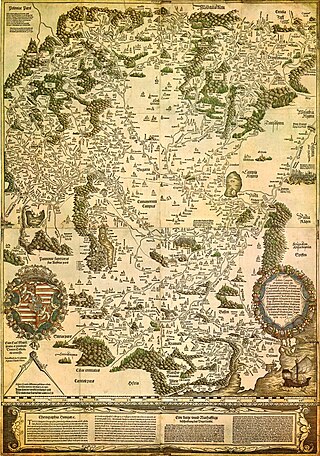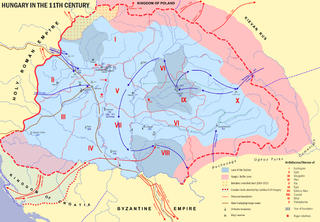Related Research Articles

The Kingdom of Hungary held a noble class of individuals, most of whom owned landed property, from the 11th century until the mid-20th century. Initially, a diverse body of people were described as noblemen, but from the late 12th century only high-ranking royal officials were regarded as noble. Most aristocrats claimed ancestry from chieftains of the period preceding the establishment of the kingdom around 1000; others were descended from western European knights who settled in Hungary. The lower-ranking castle warriors also held landed property and served in the royal army. From the 1170s, most privileged laymen called themselves royal servants to emphasize their direct connection to the monarchs. The Golden Bull of 1222 established their liberties, especially tax exemption and the limitation of military obligations. From the 1220s, royal servants were associated with the nobility and the highest-ranking officials were known as barons of the realm. Only those who owned allods – lands free of obligations – were regarded as true noblemen, but other privileged groups of landowners, known as conditional nobles, also existed.

Gesta Hungarorum, or The Deeds of the Hungarians, is the earliest book about Hungarian history which has survived for posterity. Its genre is not chronicle, but gesta, meaning "deeds" or "acts", which is a medieval entertaining literature. It was written in Latin by an unidentified author who has traditionally been called Anonymus in scholarly works. According to most historians, the work was completed between around 1200 and 1230. The Gesta exists in a sole manuscript from the second part of the 13th century, which was for centuries held in Vienna. It is part of the collection of Széchényi National Library in Budapest.

The Golden Bull of 1222 was a golden bull, or edict, issued by Andrew II of Hungary. King Andrew II was forced by his nobles to accept the Golden Bull (Aranybulla), which was one of the first examples of constitutional limits being placed on the powers of a European monarch. The Golden Bull was issued at the year 1222 diet of Fehérvár. The law established the rights of the Hungarian nobility, including the right to disobey the King when he acted contrary to law. The nobles and the church were freed from all taxes and could not be forced to go to war outside of Hungary and were not obligated to finance it. This was also a historically important document because it set down the principles of equality for all of the nation's nobility. Seven copies of the edict were created, one for each of the following institutions: to the Pope, to the Knights Templar, to the Knights Hospitaller, to the Hungarian king itself, to the chapters of Esztergom and Kalocsa and to the palatine.

In heraldry, crows, rooks, and ravens are not distinguished from each other. As with all birds that are not eagles, a crow or raven is depicted by default as close, but they can uniquely be blazoned as speaking. Crows may also be called corbies, as in the canting arms of Corbet.
The ispán or count was the leader of a castle district in the Kingdom of Hungary from the early 11th century. Most of them were also heads of the basic administrative units of the kingdom, called counties, and from the 13th century the latter function became dominant. The ispáns were appointed and dismissed by either the monarchs or a high-ranking royal official responsible for the administration of a larger territorial unit within the kingdom. They fulfilled administrative, judicial and military functions in one or more counties.
John, also Joan or Ioan, was a cneaz mentioned in the Diploma of the Joannites issued by King Béla IV of Hungary (1235–1270) on 2 July 1247; the diploma granted territories to the Knights Hospitaller in the Banate of Severin and Cumania. John held a kenazate which was given to the knights by the king. His kenazate lay in southern Oltenia.

Anonymus Bele regis notarius or Master P. was the notary and chronicler of a Hungarian king, probably Béla III. Little is known about him, but his latinized name began with P, as he referred to himself as "P. dictus magister".

A castle warrior or castle serf was a landholder obliged to provide military services to the ispán or head of a royal castle district in the medieval Kingdom of Hungary. Castle warriors "formed a privileged, elite class that ruled over the mass of castle folk" from the establishment of the kingdom around 1000 AD. Due to the disintegration of the system of castle districts, many castle warriors became serfs working on the lands of private landholders in the 13th and 14th centuries; however, some of them were granted a full or "conditional noble" status.

A conditional noble or predialist was a landowner in the Kingdom of Hungary who was obliged to render specific services to his lord in return for his landholding, in contrast with a "true nobleman of the realm" who held his estates free of such services. Most conditional nobles lived in the border territories of the kingdom, including Slavonia and Transylvania, but some of their groups possessed lands in estates of Roman Catholic prelates. Certain groups of conditional nobility, including the "ecclesiastic nobles" and the "nobles of Turopolje" preserved their specific status until the 19th century.

The Kingdom of Hungary came into existence in Central Europe when Stephen I, Grand Prince of the Hungarians, was crowned king in 1000 or 1001. He reinforced central authority and forced his subjects to accept Christianity. Although all written sources emphasize only the role played by German and Italian knights and clerics in the process, a significant part of the Hungarian vocabulary for agriculture, religion, and state matters was taken from Slavic languages. Civil wars and pagan uprisings, along with attempts by the Holy Roman emperors to expand their authority over Hungary, jeopardized the new monarchy. The monarchy stabilized during the reigns of Ladislaus I (1077–1095) and Coloman (1095–1116). These rulers occupied Croatia and Dalmatia with the support of a part of the local population. Both realms retained their autonomous position. The successors of Ladislaus and Coloman—especially Béla II (1131–1141), Béla III (1176–1196), Andrew II (1205–1235), and Béla IV (1235–1270)—continued this policy of expansion towards the Balkan Peninsula and the lands east of the Carpathian Mountains, transforming their kingdom into one of the major powers of medieval Europe.

In the Late Middle Ages, the Kingdom of Hungary, a country in Central Europe, experienced a period of interregnum in the early 14th century. Royal power was restored under Charles I (1308–1342), a scion of the Capetian House of Anjou. Gold and silver mines opened in his reign produced about one third of the world's total production up until the 1490s. The kingdom reached the peak of its power under Louis the Great (1342–1382) who led military campaigns against Lithuania, southern Italy and other faraway territories.
The ten-lanced nobles, also Szepes lancers,Spiš lancers, or lance-bearers of Szepes were group of conditional noblemen living in the Szepes region of the Kingdom of Hungary. These nobles were previously part of the contingent assigned with border guard duties in the periphery of the conquered territories in the region. In the thirteenth century, some of these groups were officially integrated into the Hungarian nobility. They received their privileges from King Béla IV of Hungary in 1243. They were obliged to equip ten knights or lancers. They were not subject to the authority of the ispán of Szepes County and tax was collected from them only if the "royal servants" were also required to pay it. Initially, they formed about 40 families, but their number decreased to less than 20 families by the 16th century. They lost their special status in 1804.
The udvornici, also udvarniks or royal serving people, was a class of half-free people who were obliged to provide well-specified services to the royal court in the medieval Kingdom of Hungary. They seem to have been descended from the Slavic population which was subjugated during the Hungarian conquest of the Carpathian Basin. Word udvornici is derived from slavic "U dvora", meaning "at/near the (royal) court". Their lord was the monarch, but they were administered by the Palatine.
The castle folk formed a class of freemen who were obliged to provide well-specified services to a royal castle and its ispán, or count, in the medieval Kingdom of Hungary. They were peasants living in villages formed in the lands pertaining to the royal castle. They tilled their estates collectively.
Prefection, also promotion of a daughter to a son, was a royal prerogative in the Kingdom of Hungary, whereby the sovereign granted the status of a son to a nobleman's daughter, authorizing her to inherit her father's landed property and transmitting noble status to her children even if she married a commoner. Such a daughter was called a praefecta in Latin.
The daughters' quarter, also known as filial quarter, was the legal doctrine that regulated the right of a Hungarian nobleman's daughter to inherit her father's property.
The militia portalis, also known as peasant militia, was the first institution that secured the peasants' permanent participation in the defence of the Kingdom of Hungary. It was established when the Diet of Hungary obliged all landowners to equip one archer for 20 peasant plots on their estates to serve in the royal army in 1397. The unprofessional soldiers were to serve in the militia only during the emergency period.

A place of authentication was a characteristic institution of medieval Hungarian law. Places of authentication were cathedral chapters and monasteries authorized to provide notarial services, including the issuing of authentic copies of documents.
Bartholomew was bishop of Veszprém in Hungary from 1226 to 1244. He had been a cleric in the service of Yolanda of Courtenay, second wife of King Andrew II of Hungary. In 1232, he sued Ban Oguz for lands before the community of the nobles of Zala County.
References
- ↑ Sebők 2010, p. 118.
- ↑ Rady 2000, p. 147.